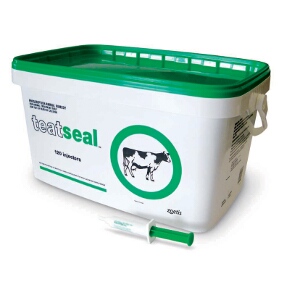Teatseal®

![]()
Transparent Pricing
![]()
Simple Ordering
![]()
Expert Advice
Australian veterinarians can now purchase our full range of products directly from Zoetis.
Zoetis Direct is a business-to-business initiative. Zoetis does not supply products directly to the general public.
VIDEO: OVERVIEW OF ZOETIS DIRECT
Zoetis Direct evolves the way we deliver value to you, your clinic and importantly to your patients. You will enjoy transparent pricing, a simple ordering system, seamless delivery and easy access to expert advice through our direct distribution commitment.
Zoetis Home / Products / Teatseal®

Teatseal® is a sterile, non-antibiotic intra-mammary infusion in the form of a viscous white paste. Teatseal® is an inert substance containing 65% bismuth subnitrate in a paraffin base.
It provides a physical barrier before the keratin plug in the teat canal has formed and after it has broken down, preventing the entry of pathogens into the udder during the early and late dry period.
Teatseal® is indicated for the prevention of mastitis in dairy cows during the non-lactating (dry) period and early post-calving.
Teatseal® is indicated for the prevention of mastitis in dairy cows during the non-lactating (dry) period and early post-calving.
Teatseal® provides a physical barrier in the teat canal after it is inserted. Teatseal mimics the teat plug, preventing the entry of bacterial pathogens into the udder.
The formation of this physical barrier acts to prevent mastitis in the dry period and early post calving.
In cows that are being dried off, Teatseal can be administered concurrently with a dry cow antibiotic. When Teatseal is used at the same time as a dry cow antibiotic, it has been shown to cut the number of mastitis cases in early lactation by up to 70%, compared to when a dry cow antibiotic is used alone.
In known low cell count cows where dry cow antibiotic may not be warranted, Teatseal can be used as the sole intramammary infusion.
In maiden heifers pre-calving, Teatseal can be administered 4 weeks prior to first calving.
Every cow is at risk of mastitis. As Teatseal is a mastitis preventative, it is relevant to every herd situation. Teatseal can prevent mastitis:
If you use blanket dry cow antibiotic therapy
If you use selective dry cow antibiotic therapy
In low cell counts cows
In high cell count cows
In maiden heifers
There is no substitute for Teatseal. Dry cow antibiotic and Teatseal work differently. They are not simple substitutes for each other. Dry cow antibiotics are used to cure existing infections when cows are dried off. Teatseal is used to prevent new infections in the udder, resulting in less mastitis early in the following lactation.
Teatseal can persist for up to 100 days after dry off.
Plan for the time and labour that treatment takes. Expect to treat 15–20 animals per hour with the Teatseal including dry cow antibiotic.
Cleanliness must be strict when administering intramammary dry off products. Teats must be disinfected thoroughly before any syringe is inserted into the teat.
Each animal should have Teatseal administered immediately after dry cow therapy, before moving on to the next animal.
Teatseal should not be massaged into the udder.
In fresh (newly calved) cows, Teatseal should be stripped out and milk withholding periods adhered to.
Key points:
You must remove Teatseal in fresh cows by stripping teats.
Change filter socks regularly.
At the first milking, strip each treated quarter at least 10–12 times – wear gloves.
Keep milk from fresh cows out of the vat for at least 8–10 milkings after calving.
Preferably use designated clusters and test buckets for the first 8–10 milkings. Avoid running milk from Teatseal treated animals through milklines during this time.
Change filter socks regularly. Clean milking equipment carefully to minimise potential residual build up.
Immediately after the last milking at drying off, prior to treatment with dry cow antibiotic and/or Teatseal, the udder should be stripped.
During the administration of the product it is important to ensure that infection is not introduced. Thoroughly clean hands prior to administration and put on gloves. Completely disinfect teat ends – a critical step. Start with the teats furthest away. Use surgical spirit or alcohol teat wipes (one per teat) and leave to air dry.
Treat all quarters. Treat the teats nearest you first. Gently squeeze the top of teats when inserting product to encourage syringe contents to stay within the teat. Be careful not to contaminate syringe nozzle. Do not insert the full depth of syringe nozzle into the teat – just the tip – otherwise damage may occur.
After infusion do not massage or squeeze the teat. Do not massage the teat or udder. Teatseal must remain in the lower part of the teat. Disinfect with a teat dip or spray.
Do not allow treated animals to lie down on bare ground or in soiled areas for 2 hours after treatment. Once the group has been treated, walk directly to a clean pasture.
Storage:
Store below 30°C (room temperature)
Schedule:
Nil
Withholding period:
Milk
Do not use within 4 days of calving where milk or milk products may be used for human consumption.
Meat
Nil.

 A Better Way To Buy
A Better Way To Buy
